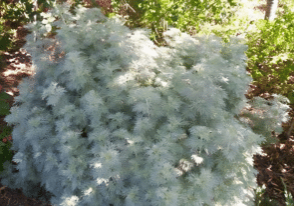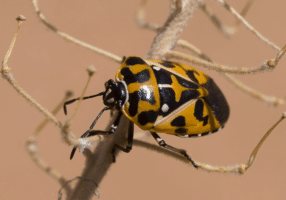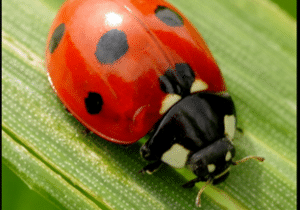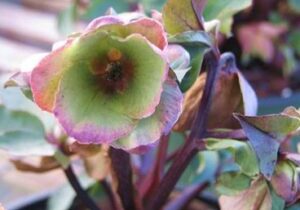By Jesse Pulliam
Known as a harlequin beetle, calico bug, fire bug, or Murgantia histrionica–its scientific name–the harlequin cabbage bug belongs to the stink bug family (Pentatomidae). It is incredibly distinctive with its dark body, accompanied by bright orange, yellow, or red markings, which give it a jester or harlequin-esque appearance. This bright coloration is a form of aposematism called aposematic coloration, which is used to warn off predators that this particular catch may prove unpalatable or even toxic.
Usually no more than 0.4 inches (1 cm) in length, the harlequin cabbage bug can be found in horticultural and agricultural areas across the United States and Central America, if you look closely enough. They are phytophagous insects, essentially meaning they are herbivores; this insect prefers plants like broccoli, kale, mustard, and cabbage, hence its name. Other plants at risk are tomatoes, corn, squash, beans, spider flowers, and sunflowers.
The harlequin cabbage bug specializes in extracting chlorophyll from plants, which can lead to plant wilting, discoloration, and even death if the harlequin bugs are left unhindered. Naturally, this leads them to be considered pests by farmers, and anyone with a mustard plant in their garden. And as an insect that is capable of laying up to 149 eggs per female, and achieving six generations per year, they can spread at an alarming rate if left unchecked.
In smaller gardens, methods often employed to deal with infestations can be as simple as spraying down affected plants with a water hose to dislodge the insects. Insecticidal soaps, diatomaceous earth, and neem oil are often effective, as well as pheromone traps; on a larger scale, another proven method is encouraging or introducing natural predators of the harlequin cabbage bug, such as lacewings, spiders, ladybugs, and assassin bugs.
In some severe cases, planting trap crops to lure the harlequin cabbage bugs away from your favored crops can be a useful solution. Fabric row covers are a great solution for preventing these insects–and other pests–from ever reaching your crops, as is regularly inspecting your garden for signs of an infestation; as Benjamin Franklin famously coined, an ounce of prevention is worth a pound of cure.
The harlequin cabbage bug, with its damaging feeding habits and potential for rapid population growth, poses a significant threat to both small gardens and large agricultural operations. By understanding the behavior and life cycle of Murgantia histrionica, gardeners and farmers can better protect their crops and maintain the health of their plants












